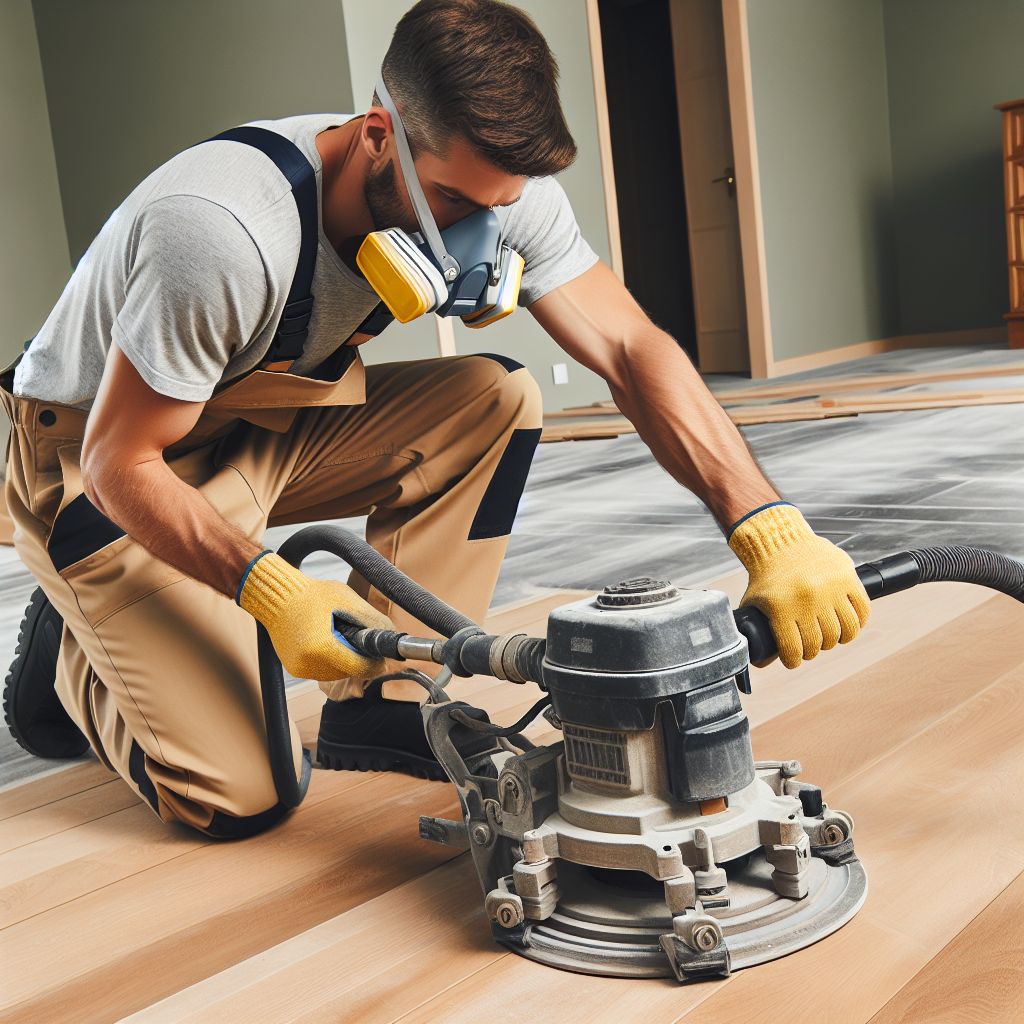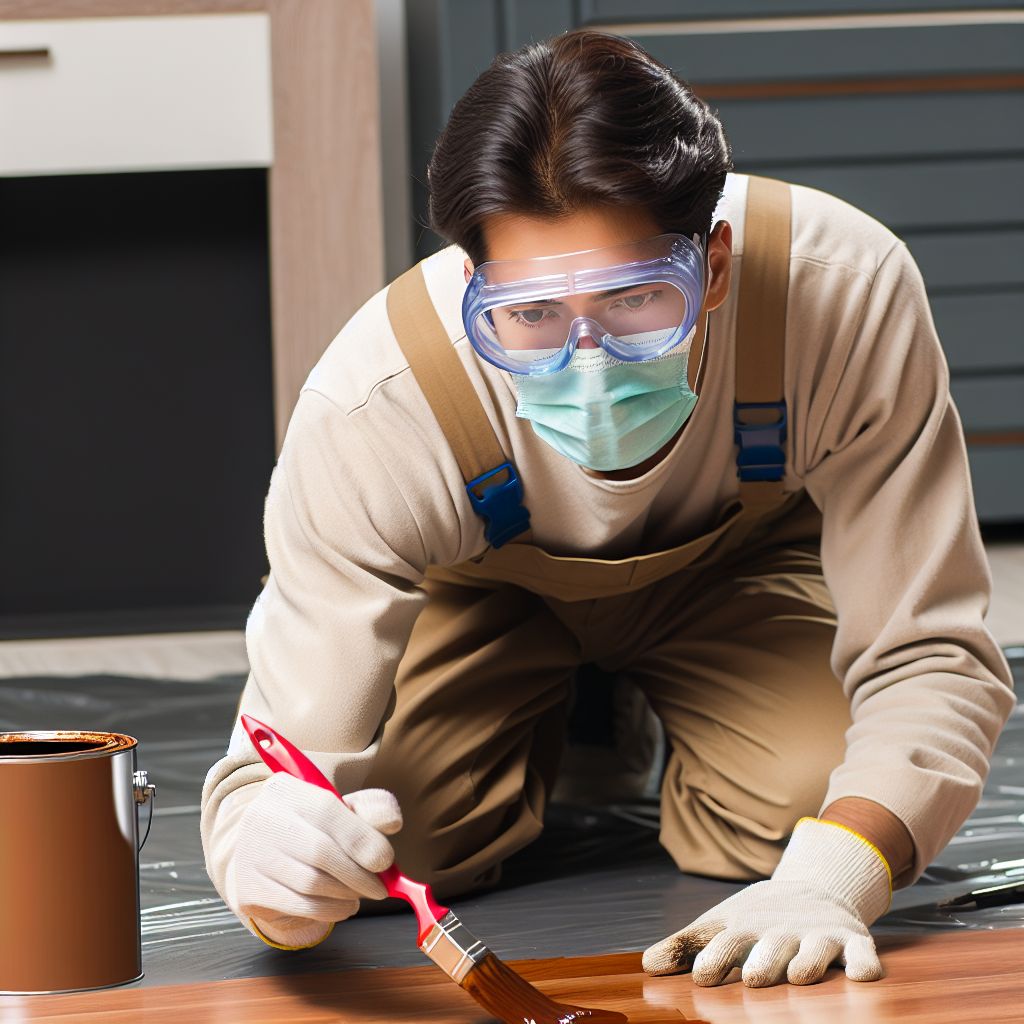
Key Takeaways
- Refinishing prefinished hardwood floors can extend their lifespan and enhance their appearance.
- It can increase your home’s value, making it a smart investment.
- Refinishing is less intrusive and costly than a complete floor replacement.
- Beveled edges and factory-applied coatings on prefinished floors can pose refinishing challenges.
- Color matching and achieving a consistent finish may require professional expertise.
Tapping into the Potential of Prefinished Hardwood Floors
Prefinished hardwood floors come ready for action, with the stain and sealant already applied. They boast a quick installation and a finish that’s tough as nails. But even the toughest floors can lose their luster over time. When they do, refinishing can be a smart move. It can breathe new life into your space, updating the look without the need for a complete floor overhaul.
Redefining Your Space with a Refinish
Imagine your floors as the canvas of your home. A refinish can be like a fresh coat of paint on that canvas, changing the entire ambiance of a room. Whether you’re going for a modern look with a matte finish or a classic shine, the possibilities are endless. Refinishing isn’t just about fixing what’s broken—it’s about reimagining your space.
The Basics: When Refinishing Makes Sense
So, when should you consider refinishing your prefinished hardwood floors? Here are a few signs:
- Visible scratches and dents that detract from the floor’s beauty.
- The finish has dulled and no longer repels water as it should.
- You’re craving a change in color or finish to update your room’s look.
If your floors are showing any of these signs, it might be time to think about refinishing.
The Brenefits of Refinishing Prefinished Floors
Refinishing your prefinished hardwood floors comes with a host of benefits. Most importantly, it extends the life of your floors. Instead of facing the expense and hassle of a full replacement, refinishing removes the top layer of damage, revealing the untouched wood beneath.
But the benefits don’t stop at longevity. Refinishing can also improve the look of your prefinished hardwood floors.
- Enhance the natural beauty of the wood, bringing out its grain and character.
- Allow you to change the color or finish to match new design trends or personal taste.
- Improve the hygiene of your home by removing old stains and odors trapped in the wood.
Extended Lifespan and Renewed Aesthetics
Think of refinishing as a reset button for your floors. Not only do you get to erase years of wear and tear, but you also get to enjoy that brand-new-floor feeling all over again. With proper care, a refinished floor can last just as long as a new one—often several decades.
Boosting Home Value with a Floor Facelift
Besides the aesthetic appeal, refinishing your floors can be a smart financial move. Beautiful hardwood floors are a selling point for many buyers, and a fresh refinish can significantly increase your home’s market value. It’s an investment that often pays for itself when it’s time to sell.
No Need for a Complete Overhaul
One of the biggest advantages of refinishing is avoiding the need for a complete floor replacement. Not only does this save on materials and labor, but it also means less disruption to your daily life. You won’t have to move out or deal with the mess of a full installation. Refinishing is a much quicker and more convenient way to update your floors.
Cost-effective Fix
When it comes to the cost of refinishing prefinished hardwood floors, think of it as an investment in the beauty and longevity of your home. On average, you’re looking at around $3 to $5 per square foot for basic wood floor refinishing, but remember, this price can vary depending on factors like repairs and staining. It’s generally more cost-effective than replacing them entirely.
Refinishing allows you to restore the existing flooring, preserving its beauty and functionality, while avoiding the higher costs associated with purchasing new materials and paying for extensive labor.
Preservation of Existing Materials
Refinishing allows you to preserve the natural beauty and character of your prefinished hardwood floors. Rather than ripping out perfectly good flooring, you can enhance its appearance and extend its lifespan through refinishing.

The Challenges of Refinishing Prefinished Surfaces
While refinishing prefinished hardwood floors has its perks, it’s not all smooth sailing. These floors come with beveled edges and a factory-applied aluminum oxide finish that’s incredibly durable. That’s great for longevity, but it makes refinishing more complicated.
Navigating the Beveled Edges and Tough Coatings
The beveled edges that give prefinished floors their seamless look can be tricky to refinish. These grooves collect dirt and grime over time, and sanding them down requires precision and the right equipment. The factory coatings are also much harder than traditional finishes, which means more elbow grease and possibly more advanced sanding equipment.
Color Matching and Consistency Concerns
Another challenge is achieving an even color and finish, especially if you’re only refinishing part of your floor. The new stain might not match the rest of your flooring, leading to an inconsistent look. This is where a professional’s touch can make all the difference, ensuring a uniform appearance across your entire floor.
Prep Work: Setting the Stage for Success
Before you start refinishing your prefinished hardwood floors, it’s essential to get everything in order. This means gathering the right tools, clearing the space, and making sure you’re set up for a safe and effective refinishing job. The key is to be thorough in your preparation—this will save you time and headaches later on.
Tools and Materials: What You’ll Need
To refinish your prefinished hardwood floors, you’ll need a few key tools and materials. Here’s a quick list to get you started:
- A power sander or sanding machine, preferably with a dust containment system
- Sanding pads or discs with various grit levels
- A hammer and nail set to sink any protruding nails
- Wood filler for repairing any cracks or holes
- Stain (if you’re changing the color) and a sealant for the final finish
- Quality brushes or rollers for applying the stain and sealant
- Protective gear, including a dust mask, safety goggles, and ear protection
Gather these items before you begin, and you’ll be set up for success.
Safety Measures to Protect Your Health and Home
Refinishing floors can be a messy and potentially hazardous job. Here’s how to protect yourself and your home:
- Ensure good ventilation by opening windows and using fans to circulate air.
- Wear a dust mask or respirator to avoid inhaling wood dust and fumes from the stain and sealant.
- Use safety goggles to protect your eyes from dust and debris.
- Ear protection is a must when using loud sanding equipment.
- Keep a fire extinguisher nearby, as some refinishing materials can be flammable.
Taking these precautions will help ensure a safe refinishing process.
When it comes to protecting your home, seal off the work area with plastic sheeting to keep dust contained. Move furniture and other items out of the room, and cover any fixed items that can’t be removed. It’s also wise to check with the manufacturer of your flooring for any specific recommendations or warnings related to refinishing.

Step-by-Step Guide to Refinishing Your Floors
Now that you’re prepped and ready, let’s walk through the refinishing process step by step. With the right approach, you can transform your worn-out prefinished floors into a stunning foundation for your home’s design.
Step 1: Assessing Your Floor’s Condition
Before you start, take a good look at your floors. Check for deep scratches, dents, or damaged areas that may need extra attention or repair. If you find nails sticking out, use a hammer and nail set to sink them below the surface. This prevents damage to your sanding equipment and ensures a smooth finish.
Step 2: Stripping Away the Old: The Sanding Process
The first step in refinishing your floors is to remove the old finish. This is done through sanding, which strips away the top layer of the wood, including any scratches, dents, and the existing stain and sealant. It’s a key part of the process that requires attention to detail and the right equipment.
Sanding pads come in various grit levels, from coarse to fine. Start with a coarser grit to remove the old finish and work your way up to finer grits for a smooth surface. Typically, you might start with a 36-grit sandpaper and progress to 60-grit, then 80-grit, and finish with 100-grit or higher for the smoothest texture.
Remember, sanding requires patience. Rushing through this step can leave uneven areas or swirl marks, so take your time and sand evenly across the entire floor. After sanding, vacuum up the dust and wipe down the floors with a tack cloth to ensure a clean, dust-free surface for staining.
Step 3: Staining with Purpose: Selecting and Applying Your New Color
If you’re looking to change the color of your floors, staining is your next step. Choose a stain that complements your home’s decor and test it in an inconspicuous area to make sure it’s the shade you want. When applying the stain, work in sections and use smooth, even strokes to avoid blotches and streaks. Allow the stain to penetrate the wood, and then wipe away any excess with a clean cloth.
After staining, let the floors dry completely according to the stain manufacturer’s instructions. This can take anywhere from a few hours to a full day, so be patient—it’s worth the wait for a beautifully stained floor.
Step 4: Sealing the Deal: Applying Topcoat for Maximum Protection
The final step in the refinishing process is to apply a topcoat. This seals in the stain and provides a protective layer against wear and tear. Whether you choose an oil-based polyurethane, a water-based polyurethane, or another type of sealant, make sure to apply it evenly and follow the manufacturer’s drying times between coats. Most floors will need at least two coats of sealant for optimal protection.

Maintenance Tips for Newly Refinished Floors
Once your floors are refinished, they’ll look brand new, but to keep them that way, you’ll need to follow some basic maintenance tips. Here’s how to care for your newly refinished hardwood floors:
Daily Practices to Extend the Floor’s Beauty
Maintaining your floors is simpler than you might think. Start with these daily practices:
- Keep them clean by sweeping, dust mopping, or vacuuming regularly to remove dirt and grit that can scratch the surface.
- Immediately wipe up any spills to prevent water damage.
- Use felt pads under furniture legs to avoid scratches when moving items around.
By following these steps and taking good care of your refinished floors, you’ll ensure they remain a stunning part of your home for years to come.

Frequently Asked Questions
How Often Should Prefinished Floors Be Refinished?
How often you refinish your prefinished hardwood floors depends on several factors, including the level of foot traffic, the presence of pets, and general wear and tear. On average, floors might need refinishing every 7 to 10 years. However, if you take good care of your floors and follow proper maintenance protocols, you might extend that period significantly.
Can DIY Refinishing Achieve Professional Results?
DIY refinishing can yield great results if you’re willing to put in the time and effort. However, it’s essential to have the right tools and a solid understanding of the refinishing process. If you’re not confident in your abilities, or if the project is extensive, hiring a professional may be the better option to ensure your floors are refinished correctly and beautifully.
How Long Does a Refinishing Project Typically Take?
The duration of a refinishing project can vary based on the size of the area and the condition of the floors. Typically, the process can take anywhere from a few days to a week. This includes preparation, sanding, staining, and applying multiple coats of sealant, with adequate drying time in between.
Are There Eco-Friendly Options for Floor Refinishing?
Yes, there are eco-friendly options available for refinishing your floors. Water-based polyurethanes and natural oil finishes are less toxic alternatives to traditional polyurethane finishes. They emit lower levels of volatile organic compounds (VOCs), making them a healthier choice for your home and the environment.
How Do I Know if My Prefinished Floor Can Be Refinished?
To determine if your prefinished floor can be refinished, you’ll need to assess the thickness of the hardwood veneer. If the veneer is at least 1/8 inch thick, it can typically be sanded and refinished. However, if the veneer is too thin, or if the floors have been refinished multiple times already, it may not be possible to refinish them again.
In conclusion, refinishing your prefinished hardwood floors can be a rewarding project that rejuvenates your home’s interior and adds value. While it comes with challenges, proper planning, and execution can lead to stunning results. Remember to weigh the pros and cons, prepare adequately, and maintain your floors post-refinishing to ensure they look great for years to come. With the right approach, your floors will continue to be a foundational element of your home’s beauty and character.





Leave a Reply